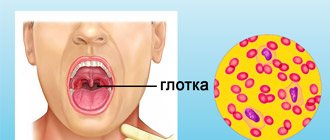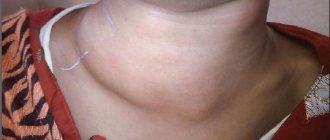Features of the development of purulent pharyngitis in children and adults
The difference between purulent pharyngitis and other types is that during its development, the epithelium of the pharynx becomes covered with plaque, consisting of waste products of pathogenic microorganisms.
Features of the disease:
- expressed by severe intoxication and high fever;
- in the chronic form, it quickly causes atrophy of the mucous membrane;
- causes the most severe consequences;
- rarely occurs as an independent disease.
The disease begins when inflammation affects the back of the throat. The process is characterized by swelling, hyperemia, granularity and enlarged lymph nodes. After a few days, a pale yellow plaque appears, caused by suppuration.
Purulent pharyngitis is a disease that occurs mainly in childhood and develops more rapidly than in adults. On average, the incubation period lasts 3-4 days, but in young children this period can be reduced to a day.
Treatment
How to treat purulent pharyngitis? A whole range of different medications are used for treatment in children and adults. Which have a beneficial effect on the mucous membranes of the throat and on the internal structures of the anatomical parts of the larynx.
- Rinse. To improve the separation of pus, solutions of Miramistin, Chlorhexidine, Furacilin, and decoctions of medicinal herbs (chamomile, calendula, sage) are used.
- Local treatment. The most commonly used antibacterial agents are Orasept, Hexasprey, Ingalipt, Bioparox.
- Antipyretic drugs (Ibuprofen, Paracetamol, Efferalgan, Nurofen).
- Antispasmodics (No-spa or Drotaverine).
Antibiotic therapy is important for effective treatment:
- Sumamed,
- Suprax,
- Azithromycin,
- Ceftriaxone.
How is purulent pharyngitis transmitted, is it contagious?
Any type of pharyngitis is transmitted by airborne droplets or household contact, but purulent pharyngitis is the most contagious. Bacteria remain on dishes, bed linen, and towels for a long time and penetrate the body of a healthy person.
Attention! Often the infection does not penetrate from the external environment, but from a source of inflammation located in the patient’s body.
A person becomes a source of infection during the incubation period, before symptoms of the disease appear. The infection ceases to be transmitted approximately a day after starting to take antibiotics, provided that the medicine was selected correctly and in the appropriate dosage.
Causes
Purulent pharyngitis can be caused by various microorganisms, but the most common variant is group A beta-hemolytic streptococcus. Slightly less frequently, the cause of the disease can be arganobacteria, the causative agent of gonorrhea, spirochetes, mycoplasma and chlamydia. In addition, acute purulent pharyngitis can also be caused by viruses, for example, adenoviruses, rhinoviruses, coronaviruses, herpetic group viruses, influenza, parainfluenza.
At risk are children from five to fifteen years of age and recruits, since most of the time they are in organized groups. The pathogen is transmitted by airborne droplets, and the rate of spread depends on the crowding of people.
Causes of purulent pharyngitis
Purulent pharyngitis almost does not occur on its own; usually the disease is a complication of inflammatory processes occurring in neighboring organs.
Initially, a viral infection begins, to which bacterial microflora joins, so the root cause of the disease most often becomes:
- adenoiditis;
- rhinitis;
- sinusitis;
- influenza, parainfluenza;
- ORZ.
- ARVI.
Bacterial causes of purulent pharyngitis are tonsillitis, otitis media, bronchitis, pneumonia, sinusitis and any other diseases caused by pathological proliferation of bacterial microflora.
Other causes of inflammation:
- mechanical damage to the larynx;
- severe allergic reactions;
- exposure to chemical agents;
- smoking;
- severe decrease in immunity;
- hypothermia of the body;
- irradiation;
- long-term use of cytostatics.
Any factor from this list contributes to the penetration and rapid proliferation of bacteria. The most commonly diagnosed infections are streptococcal, staphylococcal and pneumococcal infections. But it is the first type that is most dangerous, as it causes systemic complications.
How not to miss the first symptoms of purulent pharyngitis and quickly cure it?
Purulent pharyngitis is a serious inflammatory disease. The pathological process is localized on the back wall of the pharynx. It all starts with the catarrhal form of inflammation: swelling, hyperemia of the mucous membrane appears, enlargement of lymphoid follicles and their granularity.
Subsequently, the pathology progresses and a purulent process forms. Purulent discharge appears on the mucous membrane; upon examination, altered lymphoid follicles can be seen.
Symptoms, features of the course of the disease
Purulent pharyngitis is characterized by the following symptoms:
- Sore throat, which gets worse when eating or talking. Accompanied by soreness.
- Dry, debilitating cough. The severity and duration depend on the severity of the disease.
- With purulent pharyngitis, a peculiarity is the presence of a sensation of discharge flowing down the back wall of the pharynx. Usually this pathology becomes a complication of purulent rhinitis, so pus drains from the nose into the throat.
- There are also symptoms of intoxication: this includes headache, aches in the bones and joints, weakness, and lethargy. In response to the inflammatory reaction, an increase in temperature is observed, which with purulent pharyngitis can reach 40 degrees.
In the absence of timely treatment, a purulent process in the pharynx can spread to other organs. The infection gets into the ears, joints, and can cause heart pathologies . It is important not to start the disease, since chronicity of the disease is ultimately dangerous due to partial or complete atrophy of the nasopharyngeal mucosa.
Reasons for appearance
There may be several causes of purulent pharyngitis. The main ones are:
- Spread of purulent process from neighboring organs. This can occur in the presence of purulent otitis, rhinitis, sinusitis and other foci of inflammation that are in close proximity to the pharynx.
- Advanced acute catarrhal pharyngitis becomes purulent due to the absence, uncontrolled or ineffective treatment.
- Surgery (for example, tonsillectomy). Purulent pharyngitis is a complication of this manipulation.
- Mechanical irritation and trauma to the mucous membrane of the throat. When local immunity is insufficiently active, microorganisms settle on the damaged mucosa, causing a purulent infection. Injury can be caused by a foreign object (fish or chicken bone), as well as too hot or spicy food.
- Site of chronic infection. With a decrease in immunity, the disease that exists in the body can worsen and become the cause of secondary pathology. This also includes HIV infection, diabetes mellitus, and malignant neoplasms.
- Bad habits such as smoking and drinking alcohol negatively affect the condition of the pharyngeal mucosa. Toxic components inhibit the immune defense on the surface of the nasopharynx, as a result of which the infection becomes easier to attach. Unfavorable factors also include air polluted with smoke, dust and other harmful substances.
Treatment
The main goal of pharyngitis treatment is to eliminate the purulent process and eliminate its causative agent from the body. The presence of a severe inflammatory process implies limiting physical activity in the form of bed rest, a gentle diet that excludes too spicy, hot, cold and other irritating foods.
For the entire period of treatment, adults are strongly advised to give up bad habits, as they only aggravate the course of the disease. You need to drink at least one and a half liters of liquid per day to more quickly relieve symptoms of intoxication.
Drugs
In the presence of purulent inflammation, antibacterial therapy is necessarily prescribed. It is important to find out whether there was previous treatment with antibiotics and which ones, and if possible, to culture the material for sensitivity to drugs.
Begin therapy with penicillin antibiotics ( Amoxicillin ); it is better to use protected forms, which are more effective. If you are allergic to penicillins, which is often the case, other groups of antibacterial agents are used, for example, macrolides or cephalosporins.
Local treatment consists of using sprays that have an antimicrobial and antiseptic effect.
These include Bioparox, Hexoral, Ingalipt .
Absorbable lollipops have a similar effect. You can bring down a high temperature (more than 38 degrees) with the help of non-steroidal anti-inflammatory drugs ( Ibuprofen, Paracetamol ). It is not advisable to treat with Aspirin and Analgin to relieve pain and inflammation, since these drugs have many adverse reactions. This is especially true for children.
Procedures
Treatment of purulent pharyngitis is not limited to taking medications orally. Gargling with a solution of salt, soda and iodine has still not lost its effectiveness.
Antiseptic solutions can be purchased from pharmacies: such as Chlorhexidine or Furacilin. You need to gargle with them 3-5 times a day.
In no case should purulent foci be removed independently: this may cause further spread of infection through the tissues.
In severe cases, the otorhinolaryngologist performs an invasive procedure: puncture and pumping out pus. The indication for it is the lack of effect from conservative methods of treating the disease.
Folk remedies
Antibacterial therapy helps to relieve the main signs of the disease by eliminating the pathogen. Recovery occurs faster if you use traditional medicine.
You can use herbal infusions for drinking and gargling, which include herbs with an anti-inflammatory effect (chamomile, sage, eucalyptus). Chamomile, cypress, anise and eucalyptus oils are used to relieve symptoms.
Source: https://gaimoritus.ru/angina/gnojnyj-faringit.html
Symptoms of purulent pharyngitis in children and adults
The first signs of the disease practically do not bother the sick person. Slight soreness, discomfort when swallowing and slight weakness are almost not noticeable, but after 12-24 hours the symptoms of purulent pharyngitis become more pronounced.
The condition of adult patients is assessed as moderate or moderately severe. Children suffer the disease much worse - they are usually diagnosed with moderate to severe pharyngitis.
Symptoms of purulent pharyngitis:
- sore throat that gets worse while eating or after sleeping;
- heat;
- barking cough;
- headache;
- increased fatigue.
In children, acute pharyngitis is accompanied by drowsiness, poor appetite, and moodiness. Infants sleep poorly, refuse to eat, and cry constantly. Breastfed babies begin to spit up more often than usual.
Due to the release of large amounts of toxins by bacteria, a significant deterioration in well-being is observed. Most patients experience severe weakness, muscle pain, fever, rapid breathing and increased heart rate.
In many cases, purulent pharyngitis is accompanied by inflammation of the upper respiratory tract. In this case, symptoms of rhinitis appear - nasal congestion, the appearance of yellow-green discharge. If the inflammation goes lower, the dry cough turns into a wet one. The person begins to cough up mucus and his condition worsens significantly.
Symptoms
Purulent pharyngitis develops three to four days after contact with a sick person. In adults, the disease begins with acute pain in the throat when swallowing. At the same time, headache, weakness and increased body temperature are observed. These symptoms are caused by intoxication of the body.
In general, the condition of the patients is assessed as moderate. The temperature does not exceed 39 degrees Celsius, rapid heartbeat and breathing are observed. The mucous membrane of the pharynx is reddened, the palatine tonsils are enlarged, and they may have yellowish deposits on them. Patients complain of pain when swallowing, eating, and talking. Some patients experience a dry cough and a sore throat. In addition to inflammation in the tissues of the oropharynx, changes are also observed in the nasal passages, where pus and mucus can accumulate. It flows down the back of the throat and aggravates the inflammation.
In addition, patients also experience symptoms of general intoxication: weakness, lethargy, headache, discomfort in muscles, joints and bones. The temperature is usually subfebrile (up to thirty-seven degrees), but with the appearance of pus it can reach febrile levels.
In the average version, this is how purulent pharyngitis manifests itself. Symptoms may vary depending on the person's age and the strength of their immune system. In general, the disease lasts no more than a week and ends on its own even without treatment. Symptoms of inflammation go away, but difficulties with swallowing may remain for some time, since the tonsils will be enlarged for another couple of weeks.
Diagnostics - research methods and necessary tests
In many cases, the diagnosis of purulent pharyngitis is difficult, since the disease is caused by other inflammatory processes of the respiratory tract.
To make a diagnosis, the doctor must interview the patient and find out some facts:
- where did the deterioration in health begin;
- what diseases preceded this;
- nature of pain;
- assess general condition;
- body temperature level;
- assess the condition of the lymph nodes;
Examination of the larynx does not always help make a diagnosis, since purulent plaque is characteristic of sore throat and other diseases. The doctor should scrape off the plaque with a spatula and evaluate the result. If it is easily removed, then a diagnosis of pharyngitis or tonsillitis is made, but if the mucous membrane becomes deformed or begins to bleed, then this may indicate a more serious disease, such as diphtheria.
Diagnosis of suspected purulent pharyngitis includes examination of sputum collected from the back of the throat. But treatment is prescribed earlier, since identifying the causative agent of the infection takes about seven days.
Diagnostics
When diagnosing purulent pharyngitis, it is important to accurately determine the form of the disease, the presence of possible complications, and exclude the development of other diseases with a similar clinical course.
Additional diagnostic criteria are:
- studying the patient’s complaints and medical history,
- collection of blood and urine tests,
- throat swab,
- scraping of purulent exudate from the larynx to determine the causative agent of the disease.
Differential diagnosis allows you to quickly determine the nature of the disease and begin full treatment.
At home, it is not possible to reliably identify pathology.
Treatment of purulent pharyngitis - general recommendations and antibacterial therapy
The treatment regimen for children and adults is almost the same, except that children are prescribed safer drugs and in lower dosages. Since the disease is caused by bacteria, the main treatment for purulent pharyngitis is to take antibiotics.
Attention! Identifying the type of bacteria and choosing the agent to which they are sensitive takes too much time, so broad-spectrum antibiotics are initially prescribed. But if they are ineffective, after receiving the results, another drug is prescribed.
What groups of drugs are prescribed?
- Antibiotics: Suprax, Sumamed, Azithromycin, Cefazolin, Amoxicillin;
- Antipyretics and painkillers: Nurofen, Mig, Paracetamol, Ibuprofen;
- Local remedies: Miramistin, Hexoral, Ingalipt, Bioparox, Orasept;
- For cough inside: Gedelix, Erespal, Sinekod, dry mixture;
- Cough inhalations: Lazolvan, Ambrobene, Berodual. To soften the mucous membrane, you can use saline solution and alkaline mineral waters;
- Inhalations with antibiotics: Gentamicin, Fluimucil, Dioxidin;
- Tablets and lozenges for resorption: Lizobakt, Doctor Mom, Septolete, Faringosept;
- Gargles: Furacilin, Chlorophyllipt, Chlorhexidine, Rotocan, povidone Iodine.
It is much easier to treat purulent pharyngitis if the patient adheres to bed rest, rests more and talks less, so as not to strain the throat. It is especially important that young children observe bed rest, since they are the ones who most often experience complications.
Smokers definitely need to give up their bad habit. In order not to worsen the condition of the mucous membrane, you must avoid spicy, hot and other irritating foods, but be sure to drink 2 liters of water per day.
Treatment of purulent pharyngitis with folk remedies
Non-traditional methods of treating purulent pharyngitis are based on medicinal herbs, since many of them are natural antiseptics. For oral administration, decoctions of St. John's wort, yarrow, eucalyptus, and sage are most suitable. Such decoctions help best if you not only drink them, but also use them for rinsing.
Other treatments:
- Add a teaspoon of propolis tincture to a glass of warm milk. Take 2-3 times a day.
- Finely chop 2-3 cloves of garlic and pour a glass of boiling water. After cooling, strain and use for rinsing.
- In a glass of warm water, stir a dessert spoon of honey and 3 drops of bergamot essential oil. Use 3 times a day for rinsing.
- Mix 2 tbsp. spoons of onion juice with 1 tbsp. spoon of honey. Take a teaspoon 3 times a day.
- Grate two black radishes, compact them into a jar and pour honey. In a day you will get juice, which you need to take 2-5 times a day, 1 spoon.
Traditional treatment will be more effective if you include mows and fruit drinks from viburnum, lingonberries and cranberries in your diet. It is recommended to add fresh onions and garlic to food, as they have a strong antibacterial effect.
Treatment of purulent pharyngitis during pregnancy
Therapy during pregnancy requires special caution, since many drugs can cause negative consequences in the child. You need to be especially careful when using antibiotics. Among the approved drugs is Flemoxin, which causes less harm, but it can also be used only as prescribed by the attending physician.
If purulent pharyngitis was diagnosed at an early stage, then it is enough to use rinses with Furacilin or Miramistin, while simultaneously consuming more liquid and cranberry juices.
Doctors allow the use of Bioparox spray, since it has almost no systemic effect, but effectively suppresses the growth of bacteria in the throat. For this purpose, inhalations with antibacterial solutions are prescribed. The safest of them is Fluimucil.
Attention! It is important to coordinate all your actions with your doctor to avoid adverse consequences. Self-medication during pregnancy is unacceptable.
Physiotherapy
Physiotherapeutic procedures for purulent pharyngitis are prescribed after the temperature has decreased and the acute condition has been relieved.
Such procedures are prescribed to achieve the following goals:
- reduce inflammation;
- relieve swelling;
- improve blood circulation and lymph outflow;
- reduce intoxication;
- strengthen local and general immunity.
Physiotherapy is used in the pharynx area or acts directly on the mucous membrane of the larynx: electrophoresis, UHF therapy, magnetic therapy, ultraviolet radiation and laser therapy. These methods not only allow you to quickly cure purulent pharyngitis, but also prevent the development of adverse consequences.
Purulent pharyngitis symptoms and treatment
Among infectious diseases, purulent pharyngitis is considered one of the most unpleasant.
It is manifested by inflammation of the mucous membrane of the larynx, pharynx and lymph nodes. Trophic ulcers inevitably form in which pus accumulates.
The cause of pharyngitis is viruses that infect the upper respiratory tract and contribute to their inflammation.
Purulent pharyngitis can be acute or chronic. These forms have different symptoms, development factors and even treatment.
The first form has pronounced manifestations, but proceeds faster and with less harm to the body. The same cannot be said about the second one. A chronic disease passes much more quietly, but destroys the immune system almost to zero, opening the “doors” for other diseases.
A distinctive feature of follicular pharyngitis is the rapid formation of foci of inflammation with purulent indicators. Follicles (lymph nodes) are affected.
Most often, the disease comes as a complication during diseases such as:
- acute respiratory infections;
- ARVI;
- Flu.
EVERYONE should know about this! UNBELIEVABLE BUT TRUE! Scientists have discovered a SCARY relationship. It turns out that the cause of 50% of all ARVI diseases, accompanied by elevated temperature, as well as symptoms of fever and chills, are BACTERIA and PARASITES, such as Giardia, Ascaris and Toxocara. How dangerous are these parasites? They can deprive health and EVEN LIFE, because they directly affect the immune system, causing irreparable harm. In 95% of cases, the immune system is powerless against bacteria, and diseases will not be long in coming.
To forget about parasites once and for all, while maintaining your health, experts and scientists advise taking.....
.. »
As already mentioned, according to the severity of inflammation, pharyngitis is divided into chronic and acute. But according to the nature of the damage to the mucous tissue, this disease is divided into the following types:
- Hypertrophic;
- Atrophic;
- Catarrhal;
- Serous.
The disease can occur for a variety of reasons:
- Fungal infection;
- Viruses;
- Bacteria;
- Allergy;
- Injuries.
Symptoms of the disease do not appear immediately. First, the entire surface of the pharynx is affected - this is called catarrhal pharyngitis. Then, the infection goes deeper, which leads to granulosa pharyngitis - damage to the follicles located under the mucous membrane. These two forms belong to intermediate stages.
Specific forms follow. One of the most dangerous is gonococcal or gonorrheal pharyngitis, which is caused by the gonococcus virus.
It affects only adults and is transmitted sexually. This type of disease can hide for a long time, not show symptoms and progress unnoticed.
It can only be identified by conducting a comprehensive bacterial study.
Purulent pharyngitis tends to appear against the background of other respiratory diseases. Organizing a favorable environment for him is not at all difficult.
It is enough to catch any viral, fungal or bacterial infection and start treating it. Coupled with an unfavorable environmental environment, the presence of allergens, reduced immunity, any trauma to the respiratory tract and exposure to chemical reagents, this leads to serious problems, the name of which is purulent pharyngitis.
It is obvious that the causative agents of the disease enter the body through the respiratory tract, and therefore primarily affect them. If there are no obvious factors in the environment, most likely the infection occurred due to untreated or hidden foci of infection already existing in the body.
Acute pharyngitis is almost always accompanied by a large amount of purulent discharge. The tonsils and upper parts of the respiratory system are literally oozing with them (can be seen in the photo).
This is an unpleasant symptom that threatens to intoxicate the entire body. It is very important to remove purulent masses without allowing them to drain below. To do this, it is necessary to rinse, and the more often you do this, the better.
The acute form can become chronic for the following reasons:
- Delayed treatment;
- Using the wrong medications. This can happen if the diagnosis was made without a medical examination. Self-medication, as we know, does not lead to good;
- Treatment not completed or endured “on your feet”;
- Long-term inflammation of the throat due to other diseases;
- Frequent colds;
- Destroyed immune system.
The chronic purulent type of pharyngitis does not have pronounced symptoms of its acute form. But it is much more difficult to cure. It exhausts the body with changes of relapses and remissions, thinning the defense system.
It may seem that the disease is cured, but in reality it is not. It will make itself felt at the first hypothermia, outbreak of a cold, stress and other favorable factors.
Symptoms of the disease are divided into general - inherent in any form of the disease, and individual - distinguishing one form from another.
General signs:
- Body temperature rises to thirty-nine degrees;
- Severe headaches appear;
- Weakness, drowsiness, loss of appetite;
- Swelling and redness of the tongue, the back wall of the larynx;
- Purulent plaque and ulcers;
- Gray color of tongue, larynx. Small white dots are observed on the tonsils.
Acute pharyngitis has distinctive symptoms:
- Severe pain in the throat, difficulty swallowing;
- Enlarged lymph nodes;
- The throat is bright red;
- Ear congestion;
- Frequent coughing attacks with copious phlegm and pus;
- Exacerbation of rhinitis, bronchitis.
Granular pharyngitis manifests itself in:
- Dry mouth;
- Itching of the throat and sensation of a foreign body in it;
- Mucus and phlegm;
- Attacks of spastic “night” cough;
- Mild pain when swallowing.
Allergic form:
- Not pronounced lesions of the pharyngeal mucosa;
- Severe pain during swallowing;
- Wet and dry cough;
- Fever;
- Swelling of the tonsils and tongue;
- High body temperature.
Fungal pharyngitis:
- Slight redness of the throat;
- Plaque on the tongue is white or yellowish;
- Dry mouth;
- Yellow plugs on the tonsils.
Catarrhal form of the disease:
- A large amount of viscous mucus;
- Sore throat when swallowing and talking;
- Severe inflammation of the mucous membrane.
Treatment should begin when the first symptoms of the disease appear and continue until complete recovery. First of all, it is necessary to eliminate the factors causing the infection, and then begin to eliminate the symptoms.
In no case should you prescribe therapy yourself, without conducting a general diagnosis; any treatment for pharyngitis at home in adults must be authorized by a doctor.
Only a doctor can make the correct diagnosis and prescribe the necessary medications. In any other case, there is a high risk of the disease becoming chronic and causing serious complications.
In addition, you should not trust the first signs of improvement and stop treatment. To avoid such mistakes, the patient must be under the supervision of a specialist from beginning to end.
Purulent pharyngitis is treated exclusively comprehensively:
- Medicines: antibiotics (ampicillin, penicillin, erythromycin), antipyretics, antihistamines, medications with interferon and lysozyme;
- Vitamin and mineral complexes;
- Means for gargling and inhalation;
- Folk recipes.
One of the most important methods is rinsing. In folk medicine there are a lot of effective recipes for these purposes.
- Herbal tinctures: calendula, chamomile, sage, eucalyptus. They can be combined into collections, or used separately. Use a tablespoon of dry herbs for a glass of boiling water. They are infused for about an hour and used immediately. It is better not to leave the infusions until next time, but to prepare fresh ones each time;
- A solution of salt and soda. One teaspoon per two hundred and fifty milliliters of warm water. Stir until completely dissolved and gargle for at least half an hour. Glycerin can be added to the solution;
- Steam inhalations based on medicinal herbs. This procedure is very simple to prepare. For a liter of boiling water, take a tablespoon of each herb. Close the lid for half an hour, boil and inhale, covered with a towel over the pan. The main thing is to make sure that the steam is not too hot and does not burn your face;
- Medicines for pharyngitis for oral administration: a medium onion, two cloves of garlic, half a lemon and two tablespoons of honey. Grind all ingredients and mix. Take a teaspoon after meals for a week.
Traditional medicine recipes cannot cope alone and supplementing treatment with medications is very important. There are times when these remedies do not help at all and it is necessary to resort to completely different methods.
- Electrophoresis, ultraviolet irradiation, laser and magnetic therapy. They are used in advanced cases of chronic pharyngitis (pictured), when symptoms of other diseases are present and treatment is too complicated (for example, due to hormonal imbalance);
- Cauterization of the affected tissue. Used for hypertrophic pharyngitis.
The video in this article will help you understand how you can treat pharyngitis yourself.
Latest discussions:
Diseases of the upper respiratory tract (nasopharynx) are quite common in medical practice. They affect people of all ages, nationalities and genders. Not all of them are simple and harmless. One of the serious diseases that does not allow inaction and delays in treatment is purulent pharyngitis. According to statistics, it affects men more often than women, but for both, the symptoms are unpleasant and the diagnosis is dangerous. The presence of pus indicates that pharyngitis is in an acute stage.
The essence and features of purulent pharyngitis
Purulent pharyngitis is a disease of the pharynx (most often of an infectious nature) with painful damage to the mucous membrane and lymph nodes. Sores and pus appear on the walls of the throat (photos of such a throat can be viewed on thematic websites).
Pharyngitis of this form is dangerous, first of all, because
- this is one of the most severe forms, in which the patient’s body temperature “jumps” greatly;
- If you do not seek qualified medical help in a timely manner, serious negative consequences are possible: pus, entering other organs, will spread infection and inflammation to the joints, ears or even the heart;
- if purulent pharyngitis goes into the chronic stage, then upon its completion there will be complete atrophy of the throat tissue (the functions performed by the pharynx tissue will be impaired or completely stopped).
Causes of the disease
Pharyngitis with pus develops due to exposure to infection. In 70% of cases these are viruses, the remaining 30% can be caused by a bacterial infection, an allergic or fungal reaction, or injury.
But the most likely causes of the disease are:
1. Poor environmental situation (polluted air).
2. Infectious infection.
3. For the chronic type - predisposition to the disease.
4. Weakened immunity.
Symptoms of purulent pharyngitis
They are similar to the symptoms of other types of pharyngitis, but the presence of pus will not give the doctor the opportunity to make a mistake and prescribe the wrong treatment.
The main symptoms are:
- Increased body temperature (up to 40 degrees).
- The occurrence of pain during swallowing (which leads to a burning sensation and sore throat, dry cough, severe headaches, a feeling of a lump in the throat).
- Swelling of the mucous membrane and tongue.
- The appearance of abundant purulent plaque and bloody ulcers.
- Redness of the pharynx due to inflammation.
- General weakness.
- Enlarged occipital and submandibular lymph nodes (can be painful when pressed).
Attention! The temperature with purulent pharyngitis can rise significantly. Remember to monitor body temperature, especially in children.
These symptoms appear quite quickly, and the patient’s condition rapidly deteriorates if quality treatment is not available.
Treatment of purulent pharyngitis
All symptoms of purulent pharyngitis require immediate response and a competently prescribed, qualified course of treatment. It is selected by the doctor depending on the symptoms, causes and stage at which pharyngitis is located.
It is strictly prohibited to deviate from the prescribed course of treatment or suspend it due to a temporary improvement in the patient’s condition: this can lead to the development of a chronic stage and neglect of the disease.
Usually prescribed in combination:
They can be carried out either in ready-made pharmaceutical tinctures or herbal decoctions (with the possible addition of essential oils, for example, peach). Pharyngitis is well treated with chamomile, sage, yarrow or calendula. The procedure effectively relieves symptoms if repeated every hour. The rinse infusion must be fresh every day.
Not only medicines made from chemical components have proven themselves to be quite effective, but also treatment with drops of aloe juice, as well as preparations based on honey and onions.
Treatment will be effective if aerosols are used as painkillers and antiseptics: antiangin, faringosept, strepsils.
Doctors usually recommend eliminating all foods that can irritate the mucous membrane of the pharynx, worsening symptoms, i.e. All:
- rough,
- poorly cooked
- spicy,
- salty,
- smoked,
- cold (including ice cream).
Carbonated drinks are also prohibited. Pharyngitis with pus requires split meals, in small portions, and all food must be well-cooked.
You need to discuss with your doctor what is the best way to support your immune system. An attempt to independently prescribe treatment using traditional methods may manifest itself in the form of an allergic reaction or irritation, which, given the specific nature of the disease, is extremely undesirable.
Erythromycin, penicillin, ampicillin have performed well (they are selected depending on the tolerability of the drug, the cause and stage of the disease). Antibiotics can be prescribed not only in tablets, but also in the form of sprays or inhalation formulations. Treatment is usually carried out for 10 days, during which time all symptoms go away.
In most cases, all the previously mentioned methods turn out to be quite effective and help to quickly get rid of purulent pharyngitis. But sometimes doctors prescribe surgical intervention, which consists of puncture and forced pumping out of accumulated pus (photos and videos of this procedure can be seen on the relevant websites).
And of course, if the patient is treated at home under the supervision of a doctor, it is necessary to alleviate his condition (especially if it is a child):
- ventilate the room; the room should have cool and sufficiently humid air (this will prevent dryness in the mouth and reduce sore throat);
- give plenty of warm (not hot or cold) drinks;
- arrange bed rest for the patient.
And the main thing is not to develop pharyngitis with pus, contact your doctor in a timely manner and strictly follow all his recommendations for treatment.
One of the effective methods of treatment is inhalation. What is inhalation? How to do them correctly? Reflexologist Tatyana Sanina tells in the program “School of Health”
We also recommend reading: bioparox for pharyngitis.
Purulent pharyngitis is a disease in which inflammation of the back wall of the throat occurs with the formation of purulent exudate. Most often, this process develops as a result of injury to the throat, or due to the spread of pyogenic microorganisms from nearby foci of infection.
Purulent pharyngitis is severe, accompanied by an increase in body temperature and requires immediate medical attention.
Causes of purulent pharyngitis
The causes of purulent pharyngitis can be identified as follows:
- Spread of purulent infection to the mucous membrane of the throat from nearby foci of inflammation. This may be purulent otitis, purulent sinusitis or rhinitis, tonsillitis, mumps, mastoiditis.
- Acute pharyngitis (viral or bacterial), characterized by a complicated course. In some cases, fungal pharyngitis can lead to suppuration of the mucous membrane of the throat.
- Purulent pharyngitis can become a complication of tonsillectomy and adenotomy.
- Throat injury is one of the most common causes of purulent pharyngitis. Damage to the mucous membrane can occur from a fish bone, rough or very hot food, or other foreign objects.
- Chronic diseases, decreased immunity, diabetes mellitus, HIV infection, malignant tumor - all these factors increase the risk of developing purulent pharyngitis.
- Pharyngitis is complicated by suppuration with regular consumption of alcoholic beverages, smoking and inhalation of air contaminated with smoke, dust, and chemical impurities.
- The formation of ozena in the throat leads to the development of purulent pharyngitis. Most often this occurs in advanced stages of chronic pharyngitis, accompanied by atrophic processes in the mucous membrane of the throat.
Symptoms of purulent pharyngitis
The symptoms of purulent pharyngitis are obvious to the patient and manifest as severe discomfort in the throat, which forces the person to seek medical help.
The clinical picture of the disease is characterized by the following signs:
- Sore throat that gets worse when swallowing.
- Congestion in the ears, pain radiating to the ears.
- Persistent paroxysmal cough, accompanied by the discharge of viscous sputum mixed with pus.
- Enlargement and tenderness of the cervical and submandibular lymph nodes.
- Hyperemia of the mucous membrane of the throat.
- Swelling of the uvula, lateral ridges, tonsils.
- The presence of a mucopurulent film on the back wall of the throat, which may spread to the tonsils.
- Fetid odor from the patient's mouth.
- Erosions may appear on the back of the throat.
- Body temperature with purulent pharyngitis most often increases to high values. Sometimes there is fever with headaches, muscle and joint pain. At the same time, a person’s appetite worsens, weakness and fatigue increase.
Depending on the cause of purulent pharyngitis, the symptoms of the disease will vary somewhat. So, in the presence of ozena, a large fetid ulcer covered with crusts will be visible on the mucous membrane of the throat. With the development of purulent pharyngitis against the background of a chronic focus of infection in the sinuses, symptoms such as difficulty in nasal breathing, pain in the temples, forehead, etc. will be present. The tonsils may be riddled with purulent plugs or grooves.
Diagnosis of purulent pharyngitis is the responsibility of an otolaryngologist. The doctor interviews the patient, examines him with obligatory pharyngoscopy. To identify bacterial or viral pathogens of inflammation, it is necessary to conduct a bacterial and virological study of a smear taken from the throat.
Treatment of purulent pharyngitis Treatment of purulent pharyngitis is based on eliminating the cause that led to the development of the disease. Therapy includes local and general procedures. Most often, patients require antibiotics. Their selection is carried out on the basis of which drugs the isolated bacterial flora is sensitive to. Most often these are penicillin antibiotics, although cephalosporins and macrolides can be prescribed.
In the presence of high body temperature and severe pain, patients are recommended to take anti-inflammatory drugs, including: Ibuprofen, Paracetamol, Nimesulide. To relieve swelling, you can use hyposensitizing drugs - these are Erius, Erespal, Loratadine.
Local treatment comes down to regular gargling with sodium chloride solution, disinfectants and alkaline compounds. This is necessary to remove purulent mucus, which is a source of infection. Means for local treatment of the throat can be: Chlorophyllipt, Eludril, Stopangin, Yox. Throat sprays are easy to use and are great for situations where it is not possible to gargle. For local treatment of purulent pharyngitis, you can use such drugs as: Hexoral, Lugol, Cameton, Ingalipt, Strepsils, Orasept, Tantum Verde, Stopangin, Bioparox, Proposol. You can also use tablets and lozenges for resorption - these are Strepsils, Lyzobakt, Doctor Mom, Septolete, etc.
There are certain requirements for the food and liquid that the patient consumes. Firstly, it should not be too hot or cold. Secondly, you should avoid spicy, sour and salty foods. Thirdly, the diet during an exacerbation of the disease should be based on light foods. It’s good if fresh vegetables and fruits and fermented milk drinks are present on the table every day.
If the body temperature is not elevated, then you can do inhalations with a nebulizer. It is best to use alkaline mineral water as a medicinal solution for purulent pharyngitis. Mucolytic drugs (Ambrobene, Ambroxol, Lazolvan, etc.) are used in the presence of difficult to separate viscous sputum. These drugs are available in tablet form and in the form of a solution for inhalation.
Complex treatment of purulent pharyngitis with sanitation of all foci of infection allows you to quickly get rid of inflammation and prevent the development of complications. During treatment of the acute stage of the disease, the patient must stay at home and adhere to bed rest. Hospitalization is usually not required.
Author of the article: Lazarev Oleg Vladimirovich, otorhinolaryngologist, especially for the site ayzdorov.ru
In the practice of therapists and otorhinolaryngologists, diseases of the upper respiratory tract occur quite often. Especially in the autumn-winter period. The pathogens can be very different, but bacterial infections, such as purulent pharyngitis, are the most severe. Its symptoms and treatment will be described below in the relevant sections of the article. For starters, we can say that this disease rarely occurs in isolation. Most often this is a complication of another pathology.
Purulent pharyngitis is an infectious disease of the pharyngeal mucosa caused by pathogenic microorganisms. Most often, this process develops as a result of injury to the neck organs and the addition of secondary microflora, or as a complication of inflammatory diseases of neighboring tissues and organs.
The disease occurs against a background of severe intoxication, so the patient should immediately go to the hospital for emergency care. Poor quality or untimely treatment can seriously harm the patient and cause a lot of complications.
Purulent pharyngitis can be caused by various microorganisms, but the most common variant is group A beta-hemolytic streptococcus. Slightly less frequently, the cause of the disease can be arganobacteria, the causative agent of gonorrhea, spirochetes, mycoplasma and chlamydia. In addition, acute purulent pharyngitis can also be caused by viruses, for example, adenoviruses, rhinoviruses, coronaviruses, herpetic group viruses, influenza, parainfluenza.
At risk are children from five to fifteen years of age and recruits, since most of the time they are in organized groups. The pathogen is transmitted by airborne droplets, and the rate of spread depends on the crowding of people.
Purulent pharyngitis begins when bacteria colonize the mucous membrane of the oropharynx. Local inflammation develops, accompanied by swelling, redness and pain. The pathogen penetrates the lymphoid tissue of the tonsils, causing them to enlarge and accumulate pus in the follicles. Pus also appears on the mucous membrane of the back of the throat, it dries out and forms crusts.
At the same time, the toxins released by the bacteria improve the permeability of the vascular walls, and this allows microbial agents to enter the systemic circulation. An increase in the amount of pathogen stimulates the immune system. Antibodies to the pathogen appear in the body. But, in addition, they react to the cells of the heart muscle and kidneys, which causes serious complications.
Purulent pharyngitis develops three to four days after contact with a sick person. In adults, the disease begins with acute pain in the throat when swallowing. At the same time, headache, weakness and increased body temperature are observed. These symptoms are caused by intoxication of the body.
In general, the condition of the patients is assessed as moderate. The temperature does not exceed 39 degrees Celsius, rapid heartbeat and breathing are observed. The mucous membrane of the pharynx is reddened, the palatine tonsils are enlarged, and they may have yellowish deposits on them. Patients complain of pain when swallowing, eating, and talking. Some patients experience a dry cough and a sore throat. In addition to inflammation in the tissues of the oropharynx, changes are also observed in the nasal passages, where pus and mucus can accumulate. It flows down the back of the throat and aggravates the inflammation.
In addition, patients also experience symptoms of general intoxication: weakness, lethargy, headache, discomfort in muscles, joints and bones. The temperature is usually subfebrile (up to thirty-seven degrees), but with the appearance of pus it can reach febrile levels.
In the average version, this is how purulent pharyngitis manifests itself. Symptoms may vary depending on the person's age and the strength of their immune system. In general, the disease lasts no more than a week and ends on its own even without treatment. Symptoms of inflammation go away, but difficulties with swallowing may remain for some time, since the tonsils will be enlarged for another couple of weeks.
The disease is more often diagnosed in patients of this age category and proceeds more violently. The incubation period is reduced to twenty-four hours, the first symptom is redness of the throat. Purulent pharyngitis in this case is a secondary disease, and the source of infection can be located both in the lungs and in the paranasal sinuses. Chronic pharyngitis can be caused by reflux disease or regurgitation of the baby.
Symptoms of the disease in children correspond to those in adults:
- sore throat when swallowing and eating;
- rise in temperature;
- drowsiness, weakness and lack of appetite;
- dry hacking cough.
There are purulent and non-purulent complications of pharyngitis. The former, as a rule, are found in neighboring anatomical areas in the form of otitis, sinusitis, sinusitis, as well as phlegmon and abscesses of fatty tissue. In rare cases, foci of infection may be in joints, bones, and internal organs. Before the first antibiotics appeared, the incidence of complications was close to fifteen percent of the total number of cases. Today, such patients are less common. This is due both to the improvement in the quality and availability of treatment, and to the fact that people are less likely to see a doctor, engaging in self-medication.
Non-purulent complications include pneumonia, myocarditis, glomerulonephritis and other diseases that develop against the background of compromised immunity. This is due to the fact that pathogen antigens mimic receptors located on the surface of cells of parenchymal organs, such as the heart or kidneys.
How to identify purulent pharyngitis? A photo of the oropharynx in this case will not be particularly informative for a specialist, since redness of the mucous membrane will be observed in a significant number of diseases. In addition, only fortune tellers make a diagnosis, and at the same time treat, using photographs.
The doctor must carefully question the patient, find out the details of the disease first-hand. Then take the temperature, palpate the lymph nodes of the head and neck and, of course, look at the throat. For differential diagnosis, he may need a sterile spatula. With its help, the doctor will try to separate plaque and pus and look at the result. If the films are easily removed, and after them the tonsils do not bleed, then this is catarrhal tonsillitis or pharyngitis, and if there is a defect in the mucous membrane and bleeding, you need to think about diphtheria and refer the patient to an infectious diseases hospital.
After all manipulations, a smear is taken from the surface of the palatine tonsils with a sterile swab for microbiological examination. The discharge is sown on a nutrient medium, and after seven days, when the bacterial culture has grown, it will be possible to say exactly which pathogen provoked the disease.
Antibiotics are always used for purulent pharyngitis. The drugs of choice are penicillins, and if they are ineffective, cephalosporins or macrolides. This treatment tactic is justified if pharyngitis is caused by streptococcal bacteria. If the disease is caused by viruses, then antibiotics will not only be ineffective, but also harmful. Because bacteria that are constantly present on the mucous membranes of the mouth and nose develop resistance to treatment. As a rule, the doctor does not wait for the results of a bacteriological study, but prescribes medications empirically. He may adjust therapy later if the patient does not improve.
In order to correctly prescribe treatment, the doctor must remember some features of the causative agent of purulent pharyngitis:
- to destroy streptococcal bacteria, you must take antibiotics for at least ten days; — the sooner you start treatment, the easier the course of the disease will be.
Sometimes the doctor is unable to immediately select an antibiotic that can stop purulent pharyngitis. Treatment is considered ineffective if symptoms persist for more than three days after the start of therapy, as well as if the pathogen is released after the end of taking antibiotics. Such situations are more common in children, because they do not always accurately follow the doctor’s instructions, and are also explained by bacterial resistance.
Possible complications
In the absence of adequate therapy, purulent pharyngitis leads to complications. Most often, the disease causes an inflammatory process in neighboring anatomical areas, causing such inflammatory purulent diseases. If the infection spreads upward, then ENT diseases such as otitis media, eustachitis, sinusitis, sinusitis, and frontal sinusitis develop. With chronic inflammation, tonsillitis develops, affecting the tonsils.
When the infection spreads to the lower respiratory tract, bronchitis, pneumonia, and a retropharyngeal abscess develop. If bacteria enter the systemic bloodstream, blood poisoning is diagnosed.
With streptococcal infection, purulent pharyngitis often becomes chronic and causes the most dangerous consequences: glomerulonephritis, myocarditis, rheumatological diseases.
What should the treatment be?
Purulent pharyngitis should be treated by a doctor.
Remember this rule. It is true in all cases. With the purulent form of pharyngitis, self-medication is completely unacceptable.
Since we are dealing with an active bacterial inflammatory process, the basis of treatment is antibiotics. The pharmacological action of antibiotic drugs is aimed at suppressing the reproduction and destruction of pathogenic bacteria.
It is imperative to take into account that there is no universal antibiotic that will help against any microbe. This is another argument in favor of the fact that drug therapy should be selected by the attending physician. You will find more detailed information on this issue in the publication “Treatment of pharyngitis with antibiotics.”
Physiotherapeutic procedures are often used for purulent pharyngitis. Gargling and inhalations based on medicinal antiseptic and wound-healing solutions have proven themselves to be effective.
For a speedy recovery, the patient must follow the correct regimen. It is necessary to drink plenty of warm drinks, eat light food and breathe fresh air. Bed rest is also encouraged.
In some cases, conservative treatment may not be effective enough and may not lead to the desired results. In such a situation, the attending physician may decide on the need for surgical intervention. Most often it consists of pumping out accumulated pus.
How to prevent the occurrence of purulent pharyngitis?
It is very important to follow precautionary rules, especially during epidemics. Any disease of the upper and lower respiratory tract contributes to the penetration of infection to the larynx area. Therefore, strengthening the immune system is the most important rule for preventing purulent pharyngitis.
Other precautions:
- when visiting public places during epidemics, lubricate the nasal mucosa with Oxolinic ointment, and upon returning home, gargle with saline solution or Furacilin;
- promptly treat foci of infection, including carious teeth;
- take a course of multivitamins twice a year;
- use individual hygiene items, and if there is a sick person in the house, he should have separate utensils.
If purulent pharyngitis cannot be avoided, you should consult a specialist when the first symptoms of the disease appear. Properly prescribed medications and following the recommendations of your doctor will help you recover in 7-10 days, avoiding adverse consequences.
Complications of purulent pharyngitis
The formation of purulent foci with intoxication is a dangerous condition, as it can provoke the spread of infection throughout the body. This will lead to serious complications that threaten the patient's life.
Pathologies that are a consequence of purulent pharyngitis:
- retropharyngeal abscess is an acute purulent inflammation with clear localization in the lymph nodes or retropharyngeal space;
- purulent laryngitis - purulent inflammation of the larynx with high fever, sharp spasm of the respiratory tract and loss of voice;
- paratonsillitis, bronchitis, pneumonia - inflammatory processes of the upper and lower parts of the respiratory system;
- purulent otitis – inflammation of the middle ear with accumulation of pus in the auditory tube, tympanic cavity;
- sialadenitis - inflammation of the salivary glands;
- purulent lymphadenitis – inflammation of the lymph nodes;
- sepsis – bacterial infection of the blood of a systemic (general) nature;
- endocarditis – inflammation of the inner lining of the heart;
- Rheumatism is an inflammation of the connective tissue of the membranes of the heart.
If complications are suspected, the patient is admitted to a hospital for examination, observation and intensive treatment of purulent pharyngitis . Comprehensive treatment will help avoid dangerous consequences.
Prevention
As you know, the best way to treat a disease is its prevention. This also applies to purulent pharyngitis. To prevent pathology, local and general immunity should be increased, contact with sick people should be avoided, and diseases of the oral cavity and nasopharynx should be treated in a timely manner.
Patients should monitor the fullness of nasal breathing. Completely eliminate smoking, even passive smoking, and drinking alcoholic beverages. Avoid polluted and dusty areas, as well as inhalation of chemicals.










